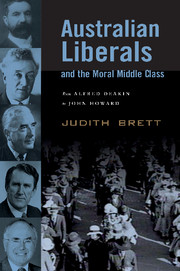Book contents
2 - Organisation and the Meaning of Fusion
Published online by Cambridge University Press: 22 September 2009
Summary
Labor's Challenge
For a political party based on commitment to independent individuals and their freedom of expression and action, political organisation is a constant problem. On the one hand it is necessary for effective political action; on the other, too much organisation risks destroying the very individuality and independence which the political action is attempting to defend. This was the Liberals' organisational dilemma as they confronted a tightly disciplined Labor Party attempting, as they saw it, to turn parliamentary politics into an arena for class warfare. One student of political parties has argued that modern political parties are distinguished far less by their program or the class of their membership than by the nature of their organisations. In considering the way Australian Liberals have distinguished themselves from Labor, organisational issues have been crucial as they have tried to balance their distinctive organisational values with their recurring organisational weakness. They did not achieve organisational stability until the formation of the Liberal Party in 1945.
When Menzies was working to persuade Australian Liberals that a new and better organised party was needed, he had two competing models of party organisation in mind. The first was the Australian Labor Party. Menzies was keen that the new party should emulate some aspects of the ALP, in particular its strong branch structure and organisational coherence.
The Labour [sic] Party, though its policy and administration are repugnant to us, is not something which exists under a different name and with a different set up in each State. It is the Australian Labour Party. Its membership depends upon common considerations all over the Continent. It has State branches and local branches … The results of this unanimity and cohesion on the organisational side has been that the disunities which exist in Labour circles are usually below the surface, are not advertised … When I consider the structure of the Australian Labour Party and realise that the political warfare to which we have been committed for a long time past by no choice of our own is a struggle between political armies, I am driven to wonder how we could ever imagine that a concerted force under one command and with one staff is to be defeated by divided units under separate commands and with no general staff.
- Type
- Chapter
- Information
- Australian Liberals and the Moral Middle ClassFrom Alfred Deakin to John Howard, pp. 13 - 34Publisher: Cambridge University PressPrint publication year: 2003



